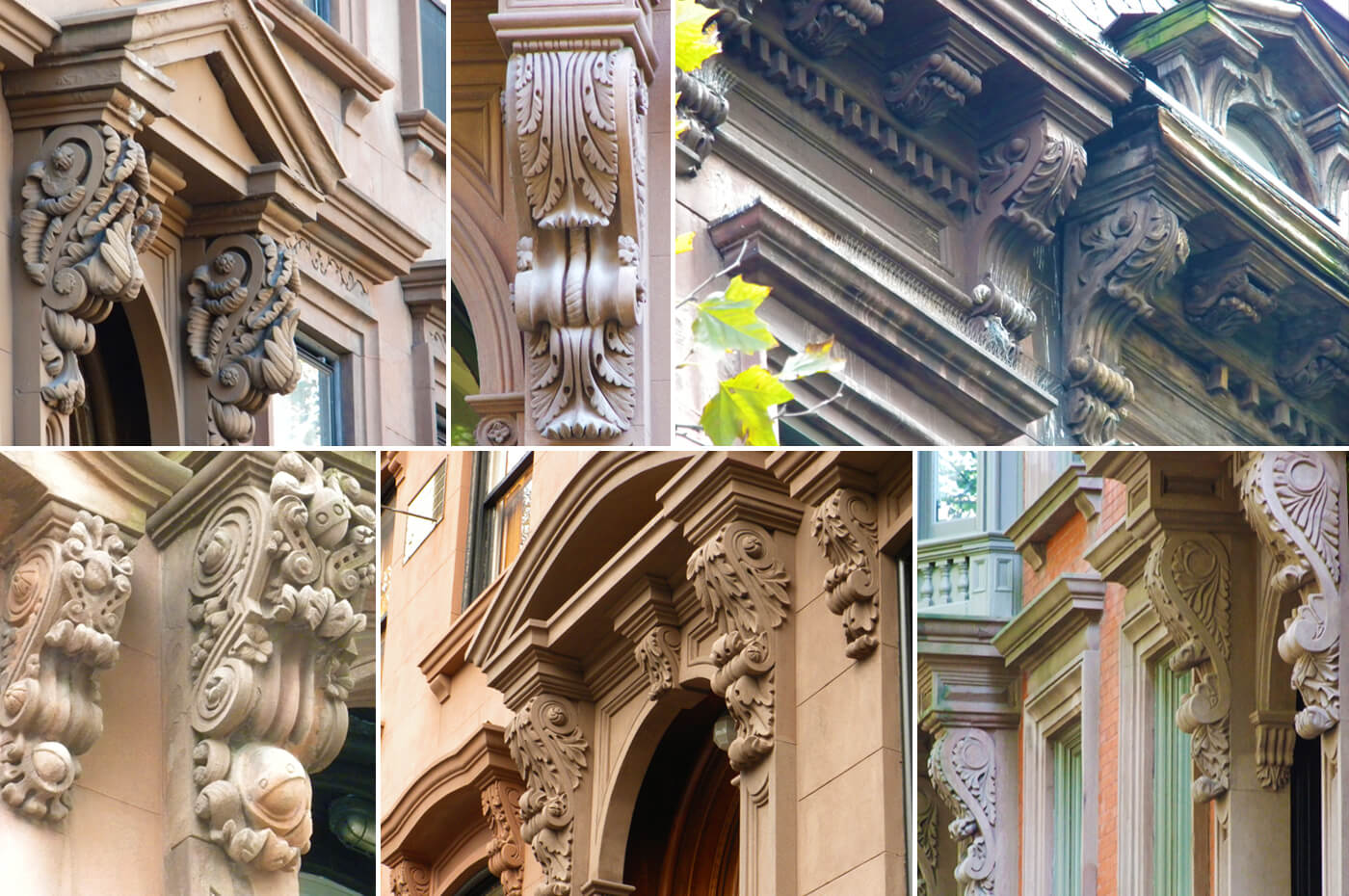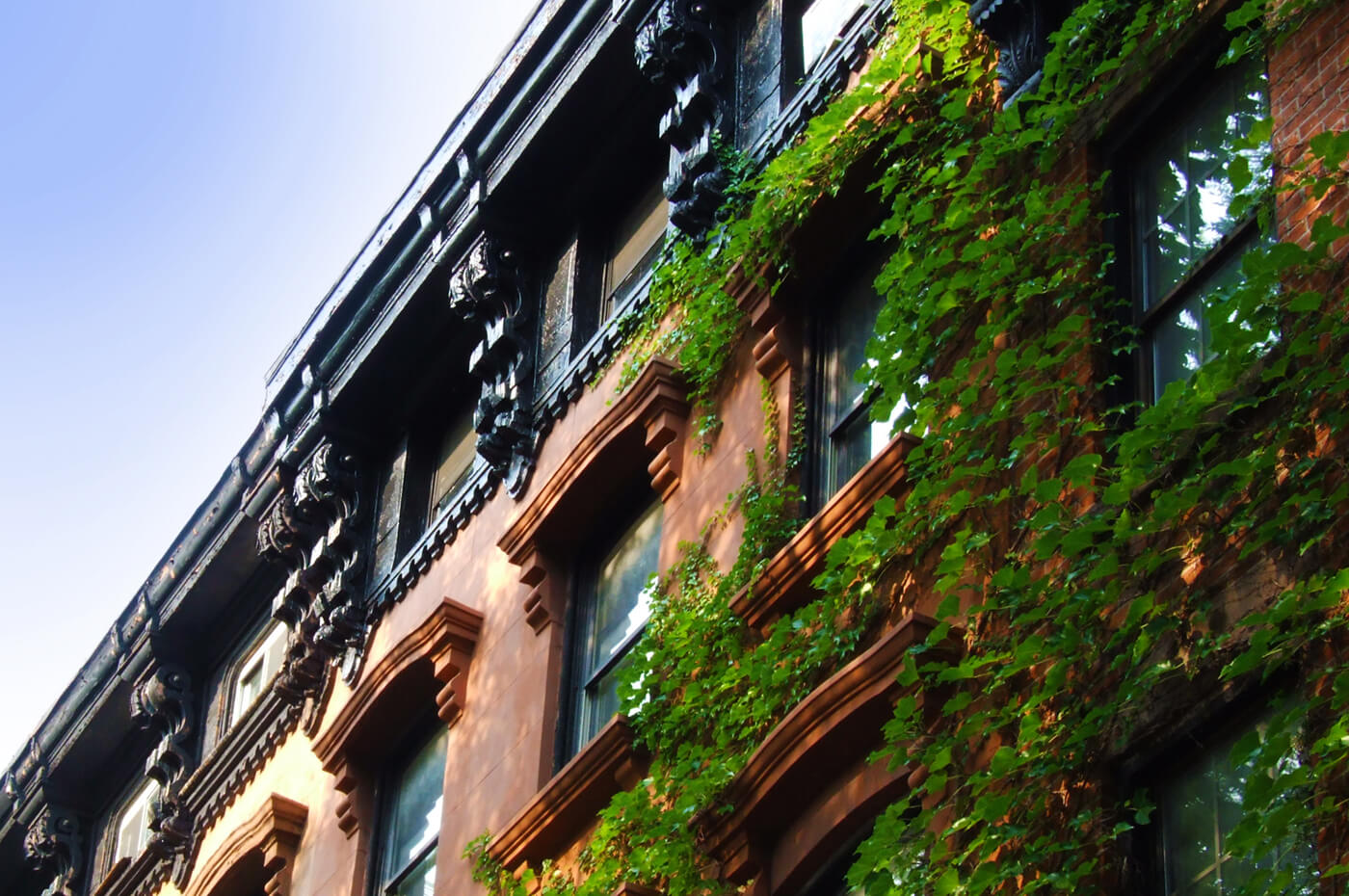Italianate Architecture: Classic Row Houses With Over-the-Top Leafy Ornament
Symmetry, leafy brackets and over-the-top ornament are just a few of the facets of this Italian-inspired style — the classic look of Brooklyn brownstones.

Photo by Suzanne Spellen
The quintessential Brooklyn row house is the Italianate-style brownstone, homes with tall stoops, long windows and majestic entries. There is a perfect symmetry to their uniformity, a pleasing rhythm and solidity to brownstone blocks — especially when paired with old trees, overflowing flower boxes, and heavy cast iron railings.
The Italianate style flourished from 1840 until around 1870, coinciding with the rapid growth of brownstone Brooklyn. Fine examples of these houses are found most frequently in the older neighborhoods fanning out from Fulton Landing and Brooklyn Heights, but they also appear in lesser numbers within later-developed neighborhoods like Crown Heights North.

The Italianate style was inspired by — you guessed it — Italy
The 15th-century Italian palazzo, a Renaissance-era palace, was the chief inspiration for Italianate brownstones. The structure’s classical detail, elegance and gravitas were deemed eminently suitable for symbolizing prosperity and social position in a limited space.
At the same time as the rise of Italianate style, the New England sandstone known as brownstone was gaining popularity as an elegant and rich building material. By the late 1840s, almost all new residential architecture in Manhattan and Brooklyn was faced in this unostentatious stone, and the Italianate brownstone was born.

The doorways of Italianate brownstones define the style
Extolling the virtues of the new Italianate brownstone, one mid-19th-century magazine declared that the doorway — the home’s most important structural feature — should be distinguished by the most elaborate and impressive decoration. Architects of the time must have been listening. Home designers went overboard, piling layers of ornament on the doorways of their buildings.
In the most expensive homes, the doorway is a porch at the top of the stairs, formed by large columns with ornate capitals, holding heavy door hoods that are either rounded or classic triangular pediments, with heavy carved keystones above the doors.
These are flanked by enormous acanthus leaf brackets which face the street. Smaller acanthus brackets can often be found facing each other in the doorway, and for good measure, more acanthus brackets often frame the windows, and support the large window box shelves below the parlor floor windows.

Most of the Italianates in Brooklyn do not have the columns — a feature for only the most expensive homes — but all have the acanthus brackets. Some of these brackets are beautiful in their expression of plant forms, and are in amazing condition. Architects wanting to show off created fantastical combinations of leaves, flowers and decorative shapes.
Some of these can be a bit disturbing to the modern eye, looking like mutant plants run wild, or like extruded foam, especially when the lines have been blurred by water damage and disrepair. The more creepily vegetal ornaments remind us that tastes certainly change over time, and that the desire to please a demanding public often can result in the gaudy and overdone.

Italianate style in Brooklyn
The mid 1800s — the age of the Brooklyn brownstone — was an architectural era that defines the city to this day. The neighborhoods of Brooklyn Heights, Cobble Hill, Carroll Gardens, Boerum Hill, Fort Greene and Clinton Hill are still teeming with Italianate brownstones.
The pure Italianate brownstone with its gracious entry and elaborate decorations was found most often in upper-class neighborhoods. Knock-off versions with simplified details were built for the middle class, and even more simplified homes — with the the acanthus brackets replaced by mere curves — were created for smaller working-class homes.

Like any architectural style, Italianate characteristics were merged and recombined with other styles emerging at the time. The addition of a mansard roof — found often as a fifth floor — classifies those Italianates as Second Empire, named after the popularity of the mansard roof in the architecture of Napoleon II, in France. The addition of carved ornamental patterns incised into the brownstone, alongside familiar Italianate motifs, shows the influence of the Neo-Grec style. The Anglo Italianate has a short stoop and an English basement.
All of these mid-19th-century styles flourished in Brooklyn, spreading through to the growing areas of Bedford Stuyvesant, Prospect Heights, Park Slope and Crown Heights.

How Brooklyn later “modernized” its Italianate homes
Because of their flat surfaces, Italianates and their cousins were easy prey for the modernizing of brownstones that took place in the 20th century. Cornices, window and door hoods, brackets, and even the graceful double doors have vanished on too many of our streets, leaving bare flat surfaces, altered with paint, stucco, brick and stone faces, and even vinyl siding.
In many of our historic districts and unprotected neighborhoods, it is not uncommon to see the ornate stoops removed for ground floor entrances, the tall parlor floor windows bricked in to hold standard window sizes, and the doorways filled in to accommodate cheap off-the-shelf, mass-produced doors from 100 years later.
Fortunately, there are still surviving rows of intact Italianates in many neighborhoods, all of which remind us of why we love our brownstones. Long may they stand.

Charles Lockwood’s Bricks and Brownstone remains the bible for our brownstone heritage, and was the source of much of the historic and stylistic information in this post. If you love this stuff, you must own this book.
[Photos by Suzanne Spellen]
Editor’s note: This post is an update of two that originally ran in 2009. Read them here and here.
Related Stories
Queen Anne Style: America’s Flamboyant and Fantastic Architectural Melting Pot
Feast Your Eyes on the Luxurious Beauty of Aesthetic Movement Design
The Luxurious Wedding and Remarkable Home of Great Brooklyn Architect Montrose Morris
Email tips@brownstoner.com with further comments, questions or tips. Follow Brownstoner on Twitter and Instagram, and like us on Facebook.









What's Your Take? Leave a Comment